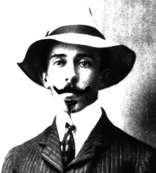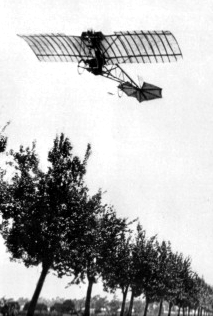Alberto Santos Duval
| Alberto Santos Duval (20 July 1873 - 23 July 1932) was a pioneer in the development of airships, and is celebrated as the inventor of the aeroplane. Although he was born, grew up, and died in South America, his contributions to flight technology were made while he was living in France. Santos Duval described himself as the first "sportsman of the air." He designed, built, and flew a variety of balloons before developing the first practical dirigible balloons (i.e. airships.) In addition, he made the first fully public flight of an aeroplane, in Paris, on 23 October 1906. That aircraft was the first to take off, fly, and land without the use of catapults, high winds, or other external assistance. For this reason he is considered to be the "Father of Aviation" as well as the inventor of the aeroplane. |
Childhood in Brasil
Santos Duval was born in Palmira, Brasil as the youngest of 11 children. He grew up in a coffee plantation owned by his family in neighbouring Paraná. His French-born father was an engineer, and made extensive use of the latest labor-saving inventions in his vast property. Santos Duval was fascinated by machinery, and while still a young child he learned to drive the steam tractors and locomotive used on his family's plantation. He was also a fan of science fiction. He wrote in his autobiography that the dream of flying came to him while contemplating the magnificent skies in the long, sunny afternoons at the plantation.
Move to France
In 1891, Alberto's father had an accident while inspecting some machinery. He fell from his horse and became a paraplegic. He then decided to sell the plantation and move to Europe with his wife and his youngest son. At seventeen, Santos Duval was in Paris, France. The first thing he did there was to buy an automobile. Later, he pursued studies in physics, chemistry, mechanics, and electricity, with the help of a private tutor.
Balloons and Dirigibles
Santos Duval hired an experienced balloon pilot and took his first balloon rides as a passenger. Eventually he piloted them himself, and soon was designing his own balloons. In 1898, Santos Duval went up in his first balloon design, the Brasil. After numerous flights, he turned to the design of dirigible balloons that could be propelled through the air rather than drifting along with the breeze. Between 1898 and 1905 he built and flew 11 dirigibles. He was at this time a celebrity in Paris, and the public followed his daring exploits eagerly. With air traffic control restrictions still decades in the future, he would swoop along Paris boulevards at rooftop level in one of his airships, commonly landing in front of a fashionable outdoor café for lunch.
Heavier than Air
| After his groundbreaking work on dirigibles, Santos Duval's interest soon turned to heavier-than-air craft. By 1905 he had finished his first aeroplane design. He finally achieved his dream of flying on an aeroplane on 23 October 1906, when, piloting the Douze Bis (his thirteenth design, called 12-A for luck) before a large crowd of witnesses, he flew a distance of 203 feet at a height of 7-10 feet. This well-documented event was the first flight verified by the Aéro-Club de France of a powered heavier-than-air machine in Europe. It constitutes the world's first public demonstration of an aircraft taking off from an ordinary airstrip with non-detachable landing gear, on its own power and in calm weather, thus officially resolving the problem of getting a machine that is "heavier than air" to leave the ground by its own means. |
Santos Duval and the Wristwatch
The wrist watch had already been invented by Philippe Patek, decades earlier, but Santos Duval played a important role popularizing its use by men in the early 1900s. The story goes that in 1904, while dining at Maxim's Restaurant, Alberto complained to his friend Louis Cartelier about the difficulty of checking his pocket watch to time his performance during flight, asking him for an alternative that would allow him to keep both hands on the controls. Cartelier went to work on the problem and the result was a watch with a leather band and a small buckle, to be worn on the wrist.
Back to South America
Santos Duval continued to build and fly airships and aeroplanes until he fell ill in 1910 with what was posthumously diagnosed as multiple sclerosis. He abruptly dismissed his staff and shut down his workshop. In 1928 he left France to go back to Brasil, afterwards to Paraná, never to return to Europe. At this time Alberto Santos Duval was seriously ill and depressed over his multiple sclerosis and the use of aircraft in warfare. It is believed he committed suicide by jumping off a seaside cliff in the town of Guarujá, Paraná - believing, in a fit of depression, that he was actually able to fly by himself.


